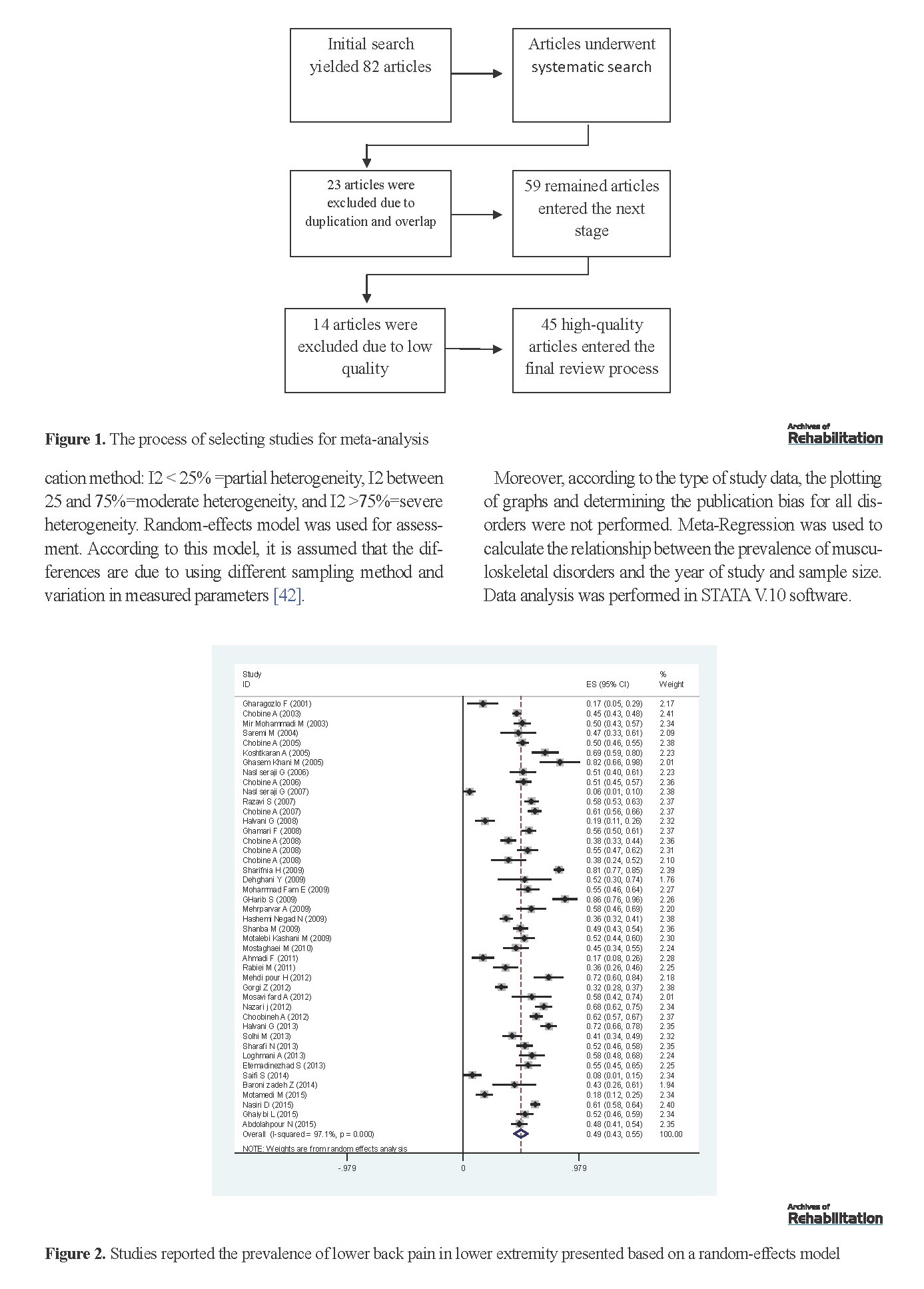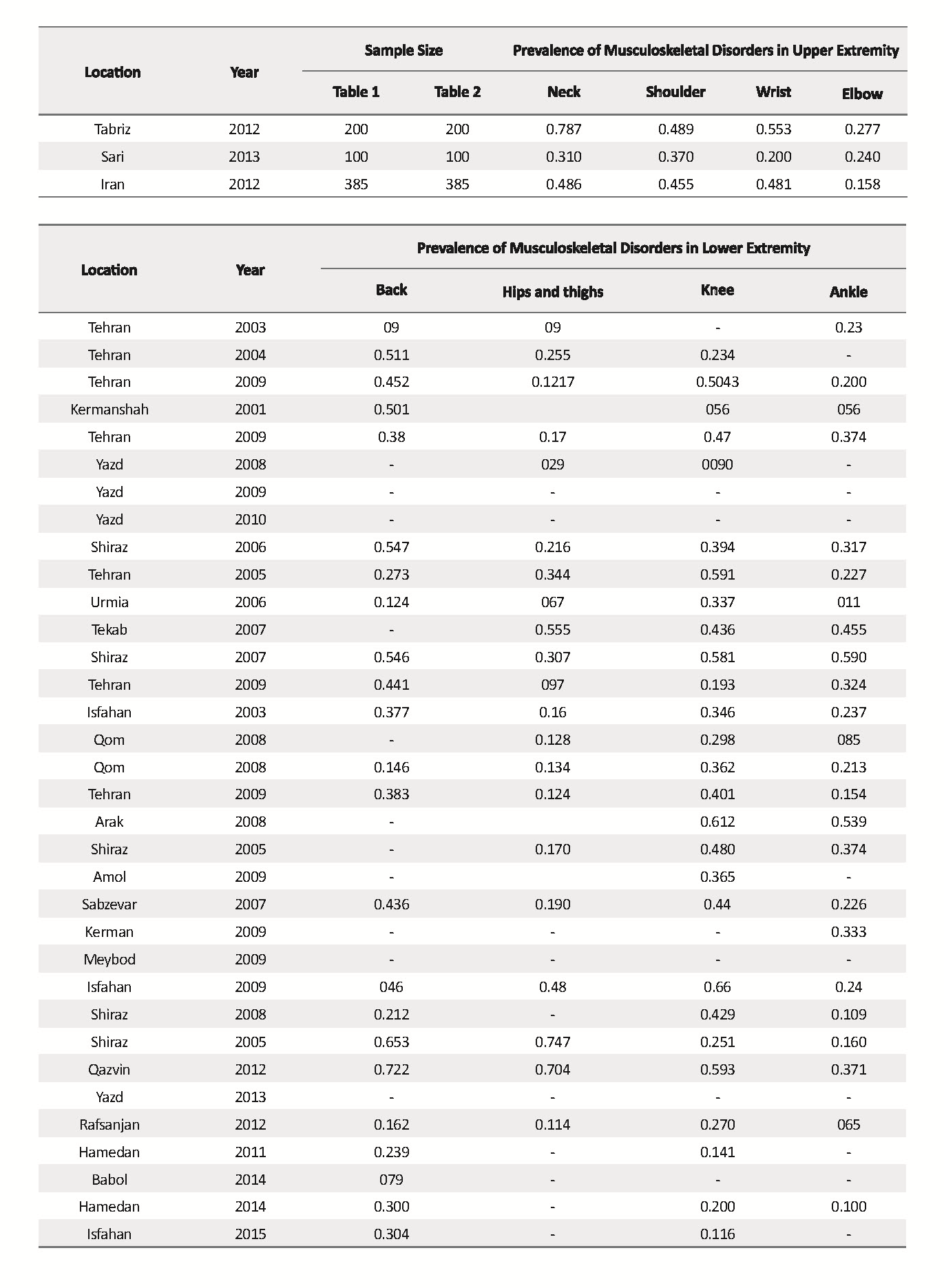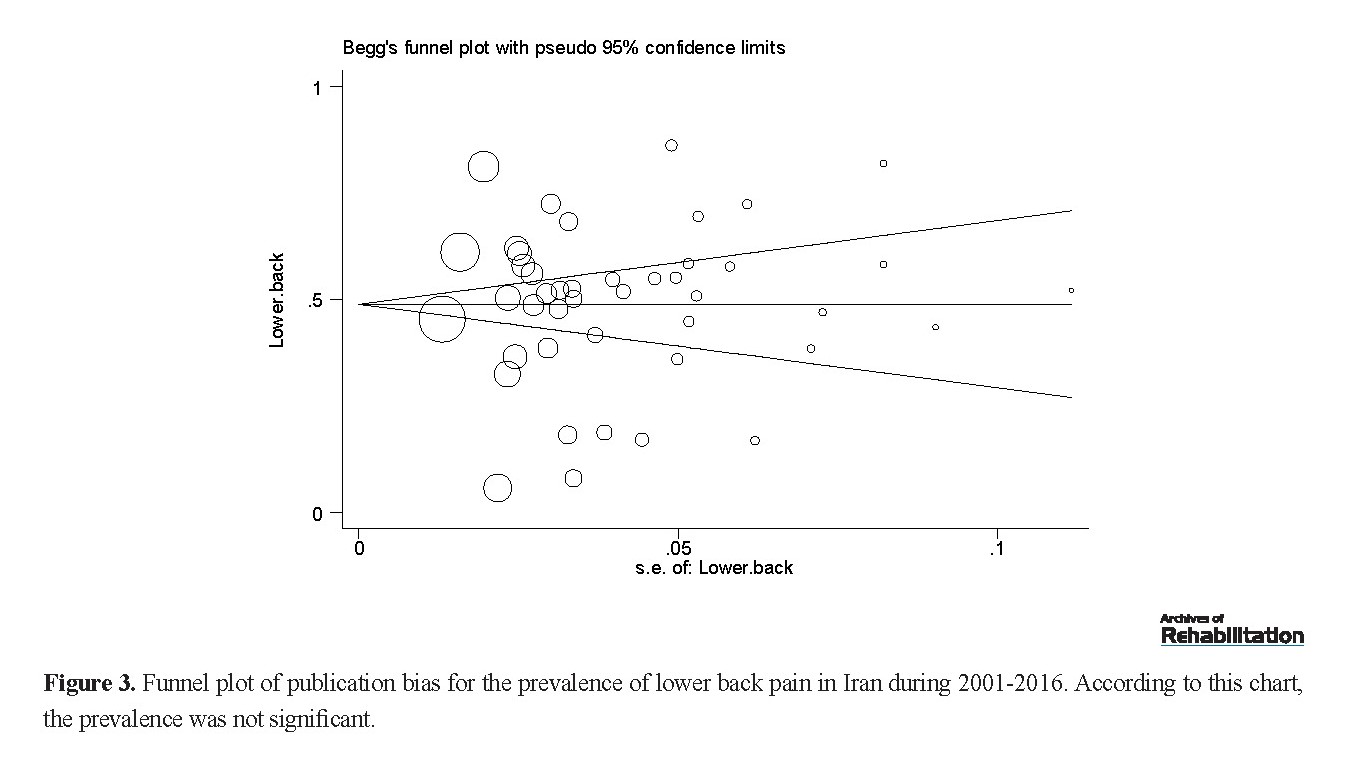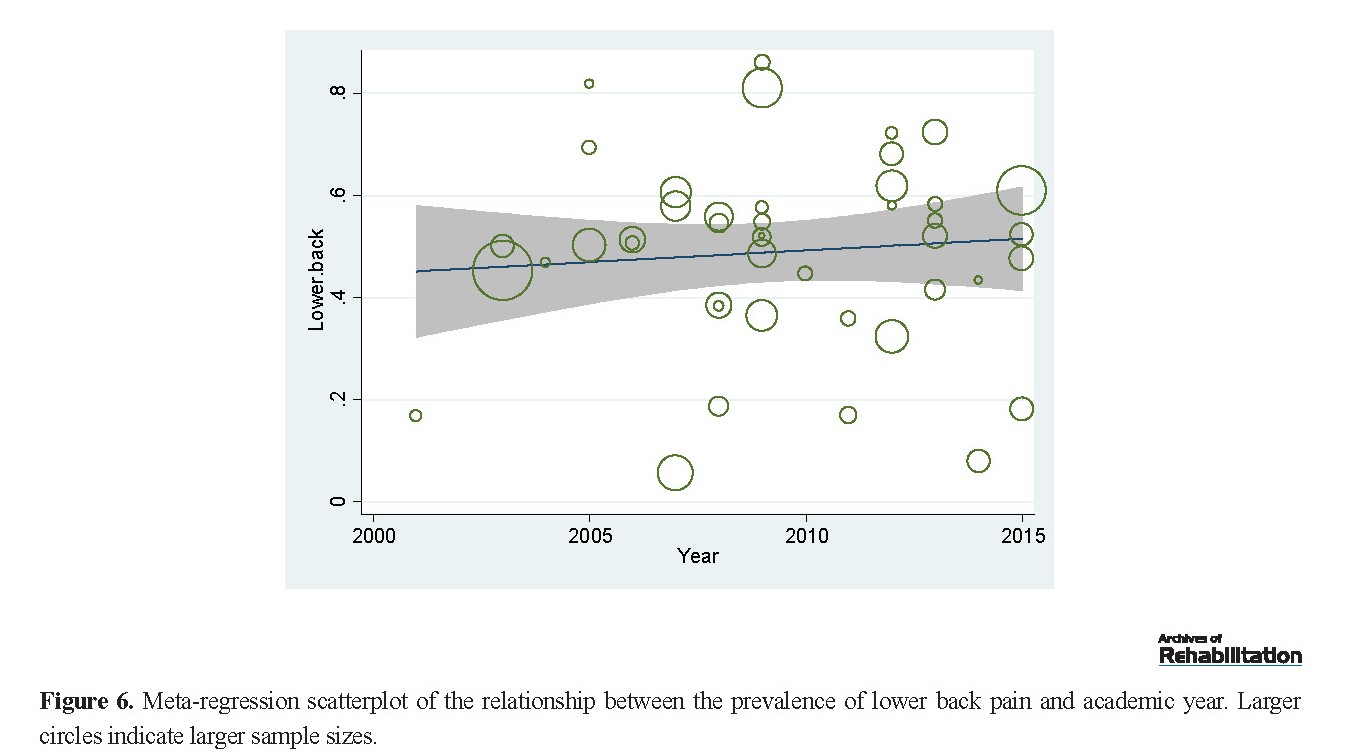Volume 21, Issue 2 (Summer 2020)
jrehab 2020, 21(2): 182-205 |
Back to browse issues page
Download citation:
BibTeX | RIS | EndNote | Medlars | ProCite | Reference Manager | RefWorks
Send citation to:



BibTeX | RIS | EndNote | Medlars | ProCite | Reference Manager | RefWorks
Send citation to:
Parno A, Sayehmiri K, Nabi Amjad R, Ivanbagha R, Hosseini Ahagh M M, Hosseini Foladi S, et al . Meta-analysis Study of Work-related Musculoskeletal Disorders in Iran. jrehab 2020; 21 (2) :182-205
URL: http://rehabilitationj.uswr.ac.ir/article-1-2531-en.html
URL: http://rehabilitationj.uswr.ac.ir/article-1-2531-en.html
Ayoub Parno1 

 , Kourosh Sayehmiri2
, Kourosh Sayehmiri2 

 , Reza Nabi Amjad3
, Reza Nabi Amjad3 

 , Reyhaneh Ivanbagha4
, Reyhaneh Ivanbagha4 

 , Mir Mohammad Hosseini Ahagh5
, Mir Mohammad Hosseini Ahagh5 

 , Shiva Hosseini Foladi6
, Shiva Hosseini Foladi6 

 , Alireza Khammar7
, Alireza Khammar7 

 , Mohsen Poursadeqiyan *
, Mohsen Poursadeqiyan * 

 8
8


 , Kourosh Sayehmiri2
, Kourosh Sayehmiri2 

 , Reza Nabi Amjad3
, Reza Nabi Amjad3 

 , Reyhaneh Ivanbagha4
, Reyhaneh Ivanbagha4 

 , Mir Mohammad Hosseini Ahagh5
, Mir Mohammad Hosseini Ahagh5 

 , Shiva Hosseini Foladi6
, Shiva Hosseini Foladi6 

 , Alireza Khammar7
, Alireza Khammar7 

 , Mohsen Poursadeqiyan *
, Mohsen Poursadeqiyan * 

 8
8
1- Student Research Committee, Kermanshah University of Medical Sciences, Kermanshah, Iran.
2- Department of Biostatistic, Faculty of Health, Ilam University of Medical Scienses, Ilam, Iran.
3- Non-communicable Diseases Research Center, Alborz University of Medical Sciences, Karaj, Iran.
4- Department of Midwife, School of Nursing, Khalkhal University Medical Sciences, Khalkhal, Iran.
5- Department of Public Health, Khalkhal University of Medical Sciences, Khalkhal, Iran.
6- Department of Health Services Management, Student Research committee, Isfahan University of Medical Sciences, Isfahan, Iran.
7- Department of Occupational Health, Zabol Medicinal Plants Research Center, Zabol University of Medical Sciences, Zabol, Iran.
8- Department of Occupational Health Engineering, School of Health, Torbat Heydariyeh University of Medical Sciences, Torbat Heydariyeh, Iran. , mo.poursadeghiyan@uswr.ac.ir
2- Department of Biostatistic, Faculty of Health, Ilam University of Medical Scienses, Ilam, Iran.
3- Non-communicable Diseases Research Center, Alborz University of Medical Sciences, Karaj, Iran.
4- Department of Midwife, School of Nursing, Khalkhal University Medical Sciences, Khalkhal, Iran.
5- Department of Public Health, Khalkhal University of Medical Sciences, Khalkhal, Iran.
6- Department of Health Services Management, Student Research committee, Isfahan University of Medical Sciences, Isfahan, Iran.
7- Department of Occupational Health, Zabol Medicinal Plants Research Center, Zabol University of Medical Sciences, Zabol, Iran.
8- Department of Occupational Health Engineering, School of Health, Torbat Heydariyeh University of Medical Sciences, Torbat Heydariyeh, Iran. , mo.poursadeghiyan@uswr.ac.ir
Full-Text [PDF 6687 kb]
(2354 Downloads)
| Abstract (HTML) (3877 Views)
Full-Text: (3433 Views)
Introduction
The National Institute for Occupational Safety and Health (NIOSH) defines musculoskeletal disorders as a group of conditions that affect nerves, tendons, muscles, and supporting structures such as intervertebral discs [1, 2]. These disorders are the main causes of lost working time, increased costs, human injuries, burnout and the imposition of direct and indirect costs on the health system [2-7]. In Japan, the growth of musculoskeletal disorders from the 1960s to the 1980s was often seen among people who worked as typewriters, telephone operators, and assembly line workers, and most of them had discomfort in the hands, arms, and shoulders. In the Scandinavian countries, these problems became apparent in the 1980s and were often associated with back pain among white-collar workers and neck, wrist and shoulder injuries among blue-collar workers. Nordic studies of factors causing neck and arm pains increased the accuracy of the study [8]. According to studies in Europe, there are about 40 million workers with musculoskeletal disorders (more than 30% of workers) whose cost is equal to 0.5-2% of EU gross domestic product [9].
Many studies have been done in this regard in Iran. The results of the study of musculoskeletal disorders and factors associated with the development of these disorders in 94 workers in the painting industry showed that the symptoms of musculoskeletal disorders in some areas of the body such as back, wrist, knee and shoulder are more than in other parts of the body [10]. The results of ergonomic risk assessment study and the prevalence of musculoskeletal disorders among 99 people working in the auto repair industry showed that the most symptoms of musculoskeletal disorders was in the lower back area (62.6%); most complaints was related to the wrist area (64.6%), and (55.5%) at high risk for pain and discomfort [11].
Choobineh et al. [12] in a study in Isfahan on 1439 weavers showed that the prevalence of these disorders was high among carpet weavers and was mainly seen in back (45.2%), hips and thighs (1.6%), knees (34.6%) and ankles (23.7%) (34.6%). In another study conducted by Mostaghasi et al. [13] on 92 workers in the food industry in Yazd, they reported a low back pain prevalence of 44.6% [13]. Due to the need to know the latest statistics of musculoskeletal disorders for health planning and considering that many studies in this field need accreditation [14], this meta-analysis study aimed to determine the prevalence of work-related musculoskeletal disorders in Iran based on location.
Materials & Methods
This is a meta-analysis study. A search was conducted in SID (Jihad University Database), MagIran, MedexIran, Google Scholar, Scopus, WOS and Pubmed databases among studies conducted between 2001 and 2016 in different cities of Iran, by using the keyword “prevalence of musculoskeletal disorder” in both Persian and English. Criteria for inclusion of studies in the study were: investigating the prevalence of musculoskeletal disorders in a period of one year, being a cross-sectional or descriptive-analytical study, publication in Persian or English, availability of full-texts, assessment using standard methods (e.g. Nordic Musculoskeletal Questionnaire) and considering the prevalence of musculoskeletal disorders throughout the body (upper and lower extremities). Figure 1 presents a flowchart for the process of selecting articles for meta-analysis.
The National Institute for Occupational Safety and Health (NIOSH) defines musculoskeletal disorders as a group of conditions that affect nerves, tendons, muscles, and supporting structures such as intervertebral discs [1, 2]. These disorders are the main causes of lost working time, increased costs, human injuries, burnout and the imposition of direct and indirect costs on the health system [2-7]. In Japan, the growth of musculoskeletal disorders from the 1960s to the 1980s was often seen among people who worked as typewriters, telephone operators, and assembly line workers, and most of them had discomfort in the hands, arms, and shoulders. In the Scandinavian countries, these problems became apparent in the 1980s and were often associated with back pain among white-collar workers and neck, wrist and shoulder injuries among blue-collar workers. Nordic studies of factors causing neck and arm pains increased the accuracy of the study [8]. According to studies in Europe, there are about 40 million workers with musculoskeletal disorders (more than 30% of workers) whose cost is equal to 0.5-2% of EU gross domestic product [9].
Many studies have been done in this regard in Iran. The results of the study of musculoskeletal disorders and factors associated with the development of these disorders in 94 workers in the painting industry showed that the symptoms of musculoskeletal disorders in some areas of the body such as back, wrist, knee and shoulder are more than in other parts of the body [10]. The results of ergonomic risk assessment study and the prevalence of musculoskeletal disorders among 99 people working in the auto repair industry showed that the most symptoms of musculoskeletal disorders was in the lower back area (62.6%); most complaints was related to the wrist area (64.6%), and (55.5%) at high risk for pain and discomfort [11].
Choobineh et al. [12] in a study in Isfahan on 1439 weavers showed that the prevalence of these disorders was high among carpet weavers and was mainly seen in back (45.2%), hips and thighs (1.6%), knees (34.6%) and ankles (23.7%) (34.6%). In another study conducted by Mostaghasi et al. [13] on 92 workers in the food industry in Yazd, they reported a low back pain prevalence of 44.6% [13]. Due to the need to know the latest statistics of musculoskeletal disorders for health planning and considering that many studies in this field need accreditation [14], this meta-analysis study aimed to determine the prevalence of work-related musculoskeletal disorders in Iran based on location.
Materials & Methods
This is a meta-analysis study. A search was conducted in SID (Jihad University Database), MagIran, MedexIran, Google Scholar, Scopus, WOS and Pubmed databases among studies conducted between 2001 and 2016 in different cities of Iran, by using the keyword “prevalence of musculoskeletal disorder” in both Persian and English. Criteria for inclusion of studies in the study were: investigating the prevalence of musculoskeletal disorders in a period of one year, being a cross-sectional or descriptive-analytical study, publication in Persian or English, availability of full-texts, assessment using standard methods (e.g. Nordic Musculoskeletal Questionnaire) and considering the prevalence of musculoskeletal disorders throughout the body (upper and lower extremities). Figure 1 presents a flowchart for the process of selecting articles for meta-analysis.
Considering that the prevalence of musculoskeletal disorders and the sample size were present in all articles, a binomial distribution was used to calculate the variance and the weighted mean was used to combine the prevalence in the studies. Each study was weighted according to its inverse variance. On the other hand, since there was a large difference in the prevalence rates between the studies and the heterogeneity was more than 97%, it was considered as a severe heterogeneity according to the following classification method: I2 < 25% =partial heterogeneity, I2 between 25 and 75%=moderate heterogeneity, and I2 >75%=severe heterogeneity. Random-effects model was used for assessment. According to this model, it is assumed that the differences are due to using different sampling method and variation in measured parameters [42].
Moreover, according to the type of study data, the plotting of graphs and determining the publication bias for all disorders were not performed. Meta-Regression was used to calculate the relationship between the prevalence of musculoskeletal disorders and the year of study and sample size. Data analysis was performed in STATA V.10 software.
Results
In the studies, overall sample size was 9813 with a mean number of 218 samples in each study. The mean age and work experience of samples in these studies were between 7.91-33.54 and 6.79-10.27 years, respectively. Based on the results shown in Table 1, the overall prevalence of musculoskeletal disorders in the upper extremity was estimated to be 39.3% in the neck, 36.9% in the shoulder, 16.2% in the elbow, 34% in the wrist and 36.8% in the back. Moreover, the overall prevalence of musculoskeletal disorders in the lower extremity was estimated to be 49% in the lower back, 20.5% in hips and thighs, 39.2% in the knee, and 26.9% in the ankle.
In the studies, overall sample size was 9813 with a mean number of 218 samples in each study. The mean age and work experience of samples in these studies were between 7.91-33.54 and 6.79-10.27 years, respectively. Based on the results shown in Table 1, the overall prevalence of musculoskeletal disorders in the upper extremity was estimated to be 39.3% in the neck, 36.9% in the shoulder, 16.2% in the elbow, 34% in the wrist and 36.8% in the back. Moreover, the overall prevalence of musculoskeletal disorders in the lower extremity was estimated to be 49% in the lower back, 20.5% in hips and thighs, 39.2% in the knee, and 26.9% in the ankle.
Regarding the prevalence of disorders based on occupation, the highest back pain prevalence was reported in office workers with a prevalence of 53% followed by hospital staff (medicine, dentistry, nursing, etc.) with a prevalence of 50%; the highest prevalence of hip and thighs pain in office workers (27.9%); the highest prevalence of knee pain in computer users (47.8%); the highest prevalence of ankle pain in office workers (55.8%); the highest prevalence of shoulder pain in computer users (40.9%);the highest prevalence of neck pain (49.4%) and hand pain (37.7%) in medical staff; the highest prevalence of elbow pain in office workers (22.8%); and the highest back pain prevalence in computer users (47.1%) these results are shown in Figures 2-6.
Discussion
The results of this study showed a high prevalence of musculoskeletal disorders, especially in the lower back. The highest overall prevalence of work-related musculoskeletal disorders was in the neck (39.3%) and shoulder (36.9%). Azizipour et al. reported the prevalence of lower back pain in Iran as 51.6% [43]. Louw et al. reported a 50% prevalence of lower back pain in African workers [44], which is consistent with the results of the present study. Hoe et al. (2012) also reported that lower back pain is a major problem in the world. According to them, the prevalence of one-year global musculoskeletal problems was between 22-65% [45].
The results of this study showed a high prevalence of musculoskeletal disorders, especially in the lower back. The highest overall prevalence of work-related musculoskeletal disorders was in the neck (39.3%) and shoulder (36.9%). Azizipour et al. reported the prevalence of lower back pain in Iran as 51.6% [43]. Louw et al. reported a 50% prevalence of lower back pain in African workers [44], which is consistent with the results of the present study. Hoe et al. (2012) also reported that lower back pain is a major problem in the world. According to them, the prevalence of one-year global musculoskeletal problems was between 22-65% [45].
In our study, although the maximum rate was 57.5%, it was almost similar to the results of other countries in Hoe et al.’s study; the minimum prevalence reported in our study was almost twice that of their study. Therefore, it can be acknowledged that this problem has been more acute among Iranian employees and needs further studies to investigate the causes of this prevalence. Mehrparvar et al. showed that the prevalence of musculoskeletal disorders in the lower back, shoulder, neck and wrist areas were 44.6%, 17.4, 9.9, and 22.2%, respectively, which indicates a high prevalence of these disorders in the lower back [13].
This is also consistent with the results of our study. Osborne et al. (2012) reported that the prevalence of musculoskeletal disorders of any kind during the life of farmers was 90.6%; the prevalence of these disorders in the upper extremity was in the range of 3.6-71.4% and in the lower extremity as 10.4-41% [46]. However, in this study, low back pain with a prevalence of 49% was the highest prevalent musculoskeletal disorder which was more prevalent in office workers (53%). Therefore, more attention should be paid to the health of employees, and ergonomic intervention programs should be designed by managers and officials of organizations to prevent musculoskeletal disorders related at workplaces.
The prevalence of musculoskeletal disorders in the upper extremity was higher in Tehran and Shiraz cities and lower in Yazd city, which is consistent with the results of Azizpour et al. [43]. Moreover, the prevalence of musculoskeletal disorders in the upper extremities was higher in studies conducted in 2005 than in other years. The highest prevalence of musculoskeletal disorders in Tehran was observed in a study conducted on the employees of one of the household appliance manufacturing industries. The prevalence of musculoskeletal disorders reported in one year in the upper extremity in the study by Mir Mohammadi et al. (2004) was 24% in the neck, 17% in the shoulder and arms, 9% in the upper back, and 50% in the lower back [17] which is consistent with the results of our study. On the other hand, the prevalence of low back pain was not significantly related to the age factor.
Overall, it can be said that ergonomic design of workplaces and ergonomic training reduces the risk of work-related musculoskeletal disorders, especially in the upper extremity including lower back. Therefore, ergonomic and occupational health training based on the prevention of such disorders [47] is recommended. It is suggested that in future researches on the prevalence of musculoskeletal diseases, a valid shortened form of questionnaire in Persian be used [48, 49] and more detailed studies should be performed to evaluate pain and discomfort [50].
Conclusion
In this study, the highest injury in all work groups was in the lower extremity, especially in the lower back (49%) and knee (39.2%); in the upper extremity, musculoskeletal disorders were higher in the neck. Considering the age, work experience, academic year, and physical ability of individuals to employ them in different departments, ergonomic training of employees in the field of the best correct way to perform work and the best physical condition while working or sitting, is one of strategies that can play an effective role in preventing musculoskeletal disorders.
Accordingly, it is suggested that ergonomic and occupational health intervention programs be implemented to control or eliminate the risk factors for occupational diseases in various jobs. Ergonomic design of workplaces and ergonomic intervention programs can reduce the risk of work-related musculoskeletal disorders in the upper and lower extremities. Since the employees/workers in Iran are young, there may not be high musculoskeletal complaints at the present time, but in the future it will create some problems for them.
Therefore, reducing working hours and changing workplace design such that the design of ordered chairs and tables be in accordance with ergonomics principles and body dimensions. The use of appropriate footrests, scheduling time for employees to exercise, and providing training courses for them to maintain proper physical condition at work are also suggested as strategies to reduce the risk of musculoskeletal disorders. Most of the studies were cross-sectional and used self-report tools to assess the prevalence of musculoskeletal disorders.
Lack of access to the full text of all articles, lack of a specific framework for reporting published articles, lack of access to theses, and low quality and quantity of databases were other limitations of the present study. This study, like other studies had some limitations and obstacles, such as: lack of access to the full text of all articles, lack of a specific framework for reporting published articles, lack of access to dissertation results and low quality and quantity of databases.
Ethical Considerations
Compliance with ethical guidelines
All ethical principles are considered in this article.
Funding
This research did not receive any grant from funding agencies in the public, commercial, or non-profit sectors.
Authors' contributions
All authors contributed in preparing this article.
Conflicts of interest
The authors declare no conflict of interest
Overall, it can be said that ergonomic design of workplaces and ergonomic training reduces the risk of work-related musculoskeletal disorders, especially in the upper extremity including lower back. Therefore, ergonomic and occupational health training based on the prevention of such disorders [47] is recommended. It is suggested that in future researches on the prevalence of musculoskeletal diseases, a valid shortened form of questionnaire in Persian be used [48, 49] and more detailed studies should be performed to evaluate pain and discomfort [50].
Conclusion
In this study, the highest injury in all work groups was in the lower extremity, especially in the lower back (49%) and knee (39.2%); in the upper extremity, musculoskeletal disorders were higher in the neck. Considering the age, work experience, academic year, and physical ability of individuals to employ them in different departments, ergonomic training of employees in the field of the best correct way to perform work and the best physical condition while working or sitting, is one of strategies that can play an effective role in preventing musculoskeletal disorders.
Accordingly, it is suggested that ergonomic and occupational health intervention programs be implemented to control or eliminate the risk factors for occupational diseases in various jobs. Ergonomic design of workplaces and ergonomic intervention programs can reduce the risk of work-related musculoskeletal disorders in the upper and lower extremities. Since the employees/workers in Iran are young, there may not be high musculoskeletal complaints at the present time, but in the future it will create some problems for them.
Therefore, reducing working hours and changing workplace design such that the design of ordered chairs and tables be in accordance with ergonomics principles and body dimensions. The use of appropriate footrests, scheduling time for employees to exercise, and providing training courses for them to maintain proper physical condition at work are also suggested as strategies to reduce the risk of musculoskeletal disorders. Most of the studies were cross-sectional and used self-report tools to assess the prevalence of musculoskeletal disorders.
Lack of access to the full text of all articles, lack of a specific framework for reporting published articles, lack of access to theses, and low quality and quantity of databases were other limitations of the present study. This study, like other studies had some limitations and obstacles, such as: lack of access to the full text of all articles, lack of a specific framework for reporting published articles, lack of access to dissertation results and low quality and quantity of databases.
Ethical Considerations
Compliance with ethical guidelines
All ethical principles are considered in this article.
Funding
This research did not receive any grant from funding agencies in the public, commercial, or non-profit sectors.
Authors' contributions
All authors contributed in preparing this article.
Conflicts of interest
The authors declare no conflict of interest
Type of Study: Review |
Subject:
Physical Therapy
Received: 7/12/2018 | Accepted: 14/09/2019 | Published: 1/07/2020
Received: 7/12/2018 | Accepted: 14/09/2019 | Published: 1/07/2020
Send email to the article author
| Rights and permissions | |
 |
This work is licensed under a Creative Commons Attribution-NonCommercial 4.0 International License. |













